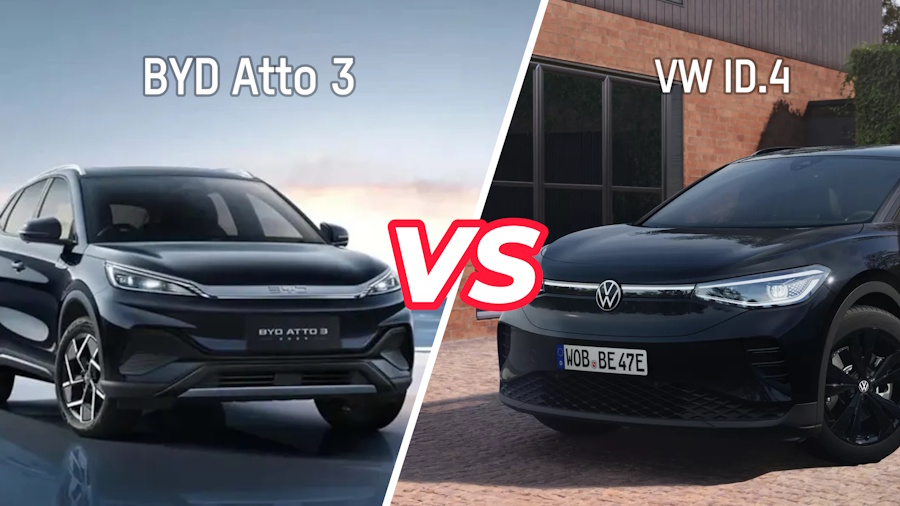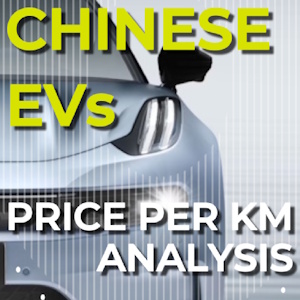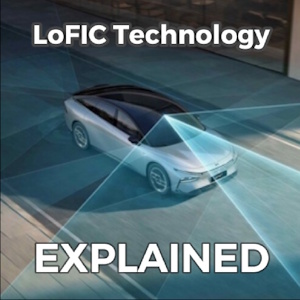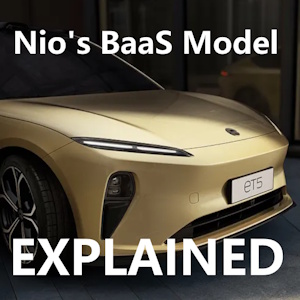Both the BYD Atto 3 and the Volkswagen ID.4 are compact electric crossovers you’ll see on European roads, but they approach the market from different angles. The Atto 3 is BYD’s value-packed C-SUV that leverages the company’s in-house battery tech (Blade battery) and a single-motor, rear-drive layout to offer a compact, well-equipped package.
The ID.4 is Volkswagen’s global compact electric SUV built on the MEB platform and offered in several battery and drivetrain variants (from single-motor RWD to dual-motor AWD and higher-power GTX flavors). Both target everyday family buyers, but the ID.4 stretches further upmarket with larger battery options and more model variety, while the Atto 3 aims for strong equipment and efficiency at a competitive price.
Table of Contents
- Interior Space, Seating, and Safety
- Battery, Charging and Range
- Performance
- Warranty
- Pricing in Europe
- Final thoughts
Interior Space, Seating, and Safety
When it comes to practicality, both the BYD Atto 3 and Volkswagen ID.4 offer spacious, family-friendly cabins, though there are some key differences. The BYD Atto 3 provides 440 litres of boot space, expanding to 1,338 litres with the rear seats folded. It doesn’t offer a front trunk (frunk), but its cleverly designed interior and flat floor make excellent use of available space. The Atto 3 is a five-seater equipped with ISOFIX mounting points on the outer rear seats and the front passenger seat, catering well to families with young children.

The Volkswagen ID.4 is slightly larger overall, and that shows in its luggage capacity — 543 litres with the seats up and 1,575 litres when folded flat. Like the Atto 3, it lacks a frunk but compensates with deeper underfloor storage and a wider tailgate opening. The ID.4 is also a five-seater, offering ISOFIX points on both outer rear seats and the front passenger seat.
In terms of safety, both the BYD Atto 3 and Volkswagen ID.4 achieved a five-star rating. In practice, both cars deliver a high level of occupant safety, with Volkswagen benefiting from its long track record and BYD showing it can meet European safety expectations right out of the gate.
Here’s how both models compare in everyday practicality and safety:
| Feature | BYD Atto 3 | Volkswagen ID.4 |
|---|---|---|
| Boot capacity (rear seats up) | 440 L | 543 L |
| Boot capacity (rear seats folded) | 1,338 L | 1,575 L |
| Frunk (front trunk) | Not available | Not available |
| Seating capacity | 5 seats | 5 seats |
| ISOFIX mounting points | Rear outer seats + front passenger seat | Rear outer seats + front passenger seat |
| Euro NCAP safety rating | ⭐⭐⭐⭐⭐ (5 stars, 2022) | ⭐⭐⭐⭐⭐ (5 stars, 2021) |
Battery, Charging and Range
The Atto 3 in Europe is offered in just two trims, but both share the same single motor and 60.5 kWh usable battery. This means performance and range figures don’t vary between versions. BYD quotes fast-charging capability up to 88 kW DC, with a 30→80% time in the region of ~29 minutes on a suitable charger. Real-world range estimates cluster in the ~300–350 km area depending on driving style.

The ID.4 is offered with multiple trims and battery sizes, ranging from 52–79 kWh pack. That larger pack pushes WLTP range figures considerably higher than the Atto 3’s, with the Pro variant show real-world ranges well over the 400-plus km band for the larger battery. DC charging capability for ID.4 variants reaches up to 185 kW peak, giving much faster top-up times than the Atto 3’s 88 kW peak. Exact numbers depend on trim, and battery.
Related: BYD EVs Available in Europe
So, let’s compare the batteries, range, and charging speeds of the Atto 3 and the ID.4. Since the ID.4 is offered with three different battery sizes, I’ll include the ID.4 Pure trim with a 52 kWh battery, the Pro trim with a 77 kWh battery, and the GTX trim with a 79 kWh battery in the table.
| Area | BYD Atto 3 | VW ID.4 Pure | VW ID.4 Pro | VW ID.4 GTX |
| Battery | 60.5 kWh | 52 kWh | 77 kWh | 79 kWh |
| Battery Type | LFP | NCM | NCM | NCM |
| Architecture | 400 V | 400 V | 400 V | 400 V |
| Range (WLTP) | 420 km | 364 km | 569 km | 529 km |
| Real-world Range | 340 km | 285 km | 445 km | 435 km |
| Consumption (WLTP) | 16 kWh/100 km | 16.6 kWh/100 km | 15.6 kWh/100 km | 16.9 kWh/100 km |
| Real-world Consumption | 17.8 kWh/100 km | 18.2 kWh | 17.3 kWh | 18.2 kWh |
| Charging Speed | 88 kWh | 145 kWh | 175 kWh | 185 kWh |
| DC Charge 10-80% | 44 min | 25 min | 28 min | 26 min |
| Heat Pump | Yes | No | No | No |
Takeaway: the Atto 3 offers a competent 60.5 kWh pack with modest but usable DC charging, and real-world range suited to daily driving. The ID.4’s larger battery options deliver substantially more WLTP range and typically faster peak DC charging.
Performance
BYD equips the Atto 3 with a single electric motor rated at 150 kW (204 PS) in its common European setup, giving a 0–100 km/h sprint in 7.3 seconds — brisk for its segment and well suited to everyday overtaking and motorway merging. The Atto 3’s tuning favours a comfortable, composed ride more than outright sportiness.

The ID.4 range is broader: the single-motor RWD versions are typically in a similar power band for everyday use (150–210 kW depending on variant), while GTX performance version raises power significantly and sharpen acceleration (5.4 seconds 0–100 km/h). In short, baseline ID.4 match or slightly exceed Atto 3 performance in everyday driving, and VW offers higher-power options that BYD’s single-motor Atto 3 does not directly match.
| Area | BYD Atto 3 | VW ID.4 Pure | VW ID.4 Pro | VW ID.4 GTX |
| Drive | Front | Rear | Rear | All-Wheel Drive |
| Max Power | 150 kW (204 hp) | 125 kW (170 hp) | 210 kW (286 hp) | 250 kW (340 hp) |
| Max Torque | 310 Nm | 310 Nm | 545 Nm | 679 Nm |
| Acceleration 0-100 km/h | 7.3 s | 9 s | 6.7 s | 5.4 s |
| Max Speed | 160 km/h | 160 km/h | 180 km/h | 180 km/h |
Takeaway: the Atto 3 is peppy for its class and feels quick around town and on the motorway; the ID.4 matches that in mainstream trims and can be notably quicker in the higher-power AWD/GTX variants.
Warranty
Warranty terms are an important ownership differentiator in Europe. BYD’s European warranty documentation and regional dealer pages show generous coverage for batteries. Commonly published terms include 8 years/200,000 km for the high-voltage battery with a minimum capacity retention guarantee (typical 70% SOH threshold), while general vehicle warranty length is 6 years/150,000 km (this might slightly vary in some countries). Always check the local BYD warranty booklet supplied at purchase for the precise dealer/country terms.
Related: MG EV Lineup in Germany – All the Electric Models Available & What’s Coming
Volkswagen’s standard warranty in many European markets for new cars is 2 years for the vehicle, and the company provides a dedicated 8 years/160,000 km warranty on the high-voltage battery guaranteeing at least 70% capacity retention for the warranty period. VW also publishes additional coverages (paint, body protection) that are region dependent.
| Warranty | BYD Atto 3 | VW ID.4 Pure | VW ID.4 Pro | VW ID.4 GTX |
| Vehicle | 6 years or 150,000 km (93,750 mi) | 2 years | 2 years | 2 years |
| Battery (Europe) | 8 years or 200,000 km (124,000 mi) /SOH* 70% | 8 years or 160,000 km (100,000 mi) / SOH* 70% | 8 years or 160,000 km (100,000 mi) / SOH* 70% | 8 years or 160,000 km (100,000 mi) / SOH* 70% |
| Battery (UK) | 8 years or 250,000 km (155,350 mi)/SOH* 70% | 8 years or 160,000 km (100,000 mi) / SOH* 70% | 8 years or 160,000 km (100,000 mi) / SOH* 70% | 8 years or 160,000 km (100,000 mi) / SOH* 70% |
| Drive Unit** | 8 years or 150,000 km (93,750 mi) | No data | No data | No data |
| Spare Parts | 1 year, or Equal to Basic Coverage*** | 2 years, unlimited mileage | 2 years, unlimited mileage | 2 years, unlimited mileage |
| Paint Work | 3 years | 3 years | 3 years | 3 years |
| Bodywork Anti-Corrosion | 12 years, unlimited mileage | 12 years, unlimited mileage | 12 years, unlimited mileage | 12 years, unlimited mileage |
| Roadside Assistance | 24+24 months | 3 years | 3 years | 3 years |
*SOH: State of Health
**Drive Unit includes Drive Motor and Drive Motor Controller
***If the warranty period of the spare part is shorter than the remaining basic coverage period of the parts on the complete vehicle, the warranty period of the part shall be extended until the remaining warranty period of basic coverage expires.
Pricing in Europe
Pricing for the BYD Atto 3 varies widely across European markets. In Spain, the Atto 3 starts at around €23,990, while in the UK the equivalent model can reach £37,705 (≈ €43,500) — nearly double, reflecting differences in taxes, import duties, and local incentives. Despite being a single model with two trims sharing the same motor and battery, regional pricing can make a significant difference for buyers.
In contrast, the Volkswagen ID.4 maintains a generally more consistent price across Europe, with typical entry-level trims starting in the mid‑€30,000s and higher-spec RWD or AWD versions ranging up into the €40,000–€50,000 band depending on options and battery size. This relatively even pricing structure makes the ID.4 easier to benchmark across countries compared to the Atto 3.
| Country | BYD Atto 3 | VW ID.4 Pure | VW ID.4 Pro | VW ID.4 GTX |
| Denmark | 269,995 DKK (36,170 €) | 299.995 DKK (40,173 €) | Check official website | Check official website |
| France | 34,990 € | 41,500 € | Check official website | Check official website |
| Germany | 38,990 € | 40,335 € | Check official website | Check official website |
| Netherlands | 40,690 € | 39,990 € | Check official website | Check official website |
| Norway | 399,900 NOK (33,820 €) | Unavailable | 437,800 NOK (37,520 €) | Check official website |
| Spain | 23,990 € | Unavailable | 34,400 € | Check official website |
| United Kingdom | 37,705 GBP (43,522 €) | 36,995 GBP (42,460 €) | Check official website | Check official website |
Note: The prices listed in the table reflect only the entry-level models in each market. In Norway, for example, the offer starts with the Pro model because the Pure model is not available there. Prices for other trims in each country can be found in the official configurator.
Final thoughts
Both the BYD Atto 3 and Volkswagen ID.4 are compelling choices for European buyers in the compact electric SUV segment, but they appeal to different priorities and market considerations. The Atto 3 impresses with its value-packed package, generous standard equipment, and efficient battery technology, making it an attractive option for buyers focused on cost-to-value and everyday practicality.
Related: Changan Deepal S07: Stylish Electric SUV Launches in Europe
However, pricing for the ID.4 is relatively consistent across Europe, which presents a challenge for BYD as it attempts to capture customers from a well-established legacy brand. Volkswagen’s extensive dealer and service network, which spans nearly every major European market, offers a level of reassurance and convenience that BYD is only beginning to develop. Availability of replacement parts, long-term servicing, and software updates are factors that consumers naturally take into account, giving the ID.4 an advantage in terms of support and reliability perception.
Featured Image Source: BYD, Volkswagen










